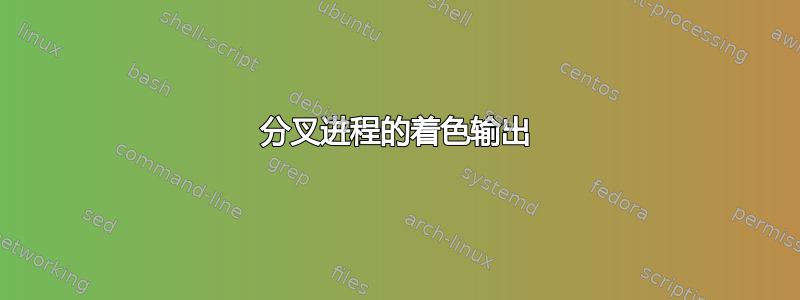
我有一个运行脚本,可以启动一些进程并将它们发送到后台
mongod & pid_mongo=$!
redis-server & pid_redis=$!
# etc.
然后,所有这些进程都会同时输出到同一个标准输出。我的问题是:是否可以为每个不同的分叉进程的输出着色,例如,其中一个输出绿色,另一个输出红色?
答案1
red=$(tput setaf 1)
green=$(tput setaf 2)
default=$(tput sgr0)
cmd1 2>&1 | sed "s/.*/$red&$default/" &
cmd2 2>&1 | sed "s/.*/$green&$default/" &
答案2
您可以通过管道通过过滤器来完成此操作,只需在每行之前和之后添加适当的 ANSI 代码即可:
http://en.wikipedia.org/wiki/ANSI_escape_sequences#Colors
经过几分钟的谷歌搜索后,我找不到一个真正可以做到这一点的工具,考虑到编写一个工具是多么容易,这有点奇怪。
这是一个使用 C 的想法:
#include <stdio.h>
#include <unistd.h>
#include <stdlib.h>
#include <fcntl.h>
#include <errno.h>
/* std=gnu99 required */
// ANSI reset sequence
#define RESET "\033[0m\n"
// length of RESET
#define RLEN 5
// size for read buffer
#define BUFSZ 16384
// max length of start sequence
#define START_MAX 12
void usage (const char *name) {
printf("Usage: %s [-1 N -2 N -b -e | -h]\n", name);
puts("-1 is the foreground color, -2 is the background.\n"
"'N' is one of the numbers below, corresponding to a color\n"
"(if your terminal is not using the standard palette, these may be different):\n"
"\t0 black\n"
"\t1 red\n"
"\t2 green\n"
"\t3 yellow\n"
"\t4 blue\n"
"\t5 magenta\n"
"\t6 cyan\n"
"\t7 white\n"
"-b sets the foreground to be brighter/bolder.\n"
"-e will print to standard error instead of standard out.\n"
"-h will print this message.\n"
);
exit (1);
}
// adds character in place and increments pointer
void appendChar (char **end, char c) {
*(*end) = c;
(*end)++;
}
int main (int argc, char *const argv[]) {
// no point in no arguments...
if (argc < 2) usage(argv[0]);
// process options
const char options[]="1:2:beh";
int opt,
set = 0,
output = STDOUT_FILENO;
char line[BUFSZ] = "\033[", // ANSI escape
*p = &line[2];
// loop thru options
while ((opt = getopt(argc, argv, options)) > 0) {
if (p - line > START_MAX) usage(argv[0]);
switch (opt) {
case '?': usage(argv[0]);
case '1': // foreground color
if (
optarg[1] != '\0'
|| optarg[0] < '0'
|| optarg[0] > '7'
) usage(argv[0]);
if (set) appendChar(&p, ';');
appendChar(&p, '3');
appendChar(&p, optarg[0]);
set = 1;
break;
case '2': // background color
if (
optarg[1] != '\0'
|| optarg[0] < '0'
|| optarg[0] > '7'
) usage(argv[0]);
if (set) appendChar(&p, ';');
appendChar(&p, '4');
appendChar(&p, optarg[0]);
set = 1;
break;
case 'b': // set bright/bold
if (set) appendChar(&p, ';');
appendChar(&p, '1');
set = 1;
break;
case 'e': // use stderr
output = STDERR_FILENO;
break;
case 'h': usage(argv[0]);
default: usage(argv[0]);
}
}
// finish 'start' sequence
appendChar(&p, 'm');
// main loop
// set non-block on input descriptor
int flags = fcntl(STDIN_FILENO, F_GETFL, 0);
fcntl(STDIN_FILENO, F_SETFL, flags | O_NONBLOCK);
// len of start sequence
const size_t slen = p - line,
// max length of data to read
rmax = BUFSZ - (slen + RLEN);
// actual amount of data read
ssize_t r;
// index of current position in output line
size_t cur = slen;
// read buffer
char buffer[rmax];
while ((r = read(STDIN_FILENO, buffer, rmax))) {
if (!r) break; // EOF
if (r < 1) {
if (errno == EAGAIN) continue;
break; // done, error
}
// loop thru input chunk byte by byte
// this is all fine for utf-8
for (int i = 0; i < r; i++) {
if (buffer[i] == '\n' || cur == rmax) {
// append reset sequence
for (int j = 0; j < RLEN; j++) line[j+cur] = RESET[j];
// write out start sequence + buffer + reset
write(output, line, cur+RLEN);
cur = slen;
} else line[cur++] = buffer[i];
}
}
// write out any buffered data
if (cur > slen) {
for (int j = 0; j < RLEN; j++) line[j+cur] = RESET[j];
write(output, line, cur+RLEN);
}
// flush
fsync(output);
// the end
return r;
}
我认为这与您将获得的效率差不多。需要write()一次性使用 ANSI 序列完成一整行 - 如果 ANSI 序列和缓冲区内容分别完成,则使用并行分叉进行测试会导致交错。
它需要编译,-std=gnu99因为getopt它不是 C99 标准的一部分,而是 GNU 的一部分。我用平行叉对此进行了一些测试;该源代码、makefile 和测试位于此处的 tarball 中:
http://cognitivedissonance.ca/cogware/utf8_colorize/utf8_colorize.tar.bz2
如果您将其与日志一起使用的应用程序记录到标准错误,请记住也将其重定向:
application 2>&1 | utf8-colorize -1 2 &
test 目录中的 .sh 文件包含一些使用示例。
答案3
您可能最好将日志重定向到特定的输出文件?
对输出进行着色有许多不同的解决方案。最简单的可能是使用GRC包裹..
答案4
您可以与 sh 内置函数一起使用的另一个选项:也适用于 ash (busybox) ;)
RED=`echo -e '\033[0;31m'`
NC=`echo -e '\033[0m'` # No Color
cmdx 2>&1 | sed "s/.*/$RED&$NC/" &
我自己写了一个shell函数来轻松地在后台运行程序。这是为busybox的灰而写的!在 bash 中也可以工作。赶紧跑:
bg_red <whatever cmd you want to run in the bg>
将以下内容放入您的 .bashrc 中
ESC="\033"
# Colors:
COLOR_RED_F="${ESC}[31m"
COLOR_GREEN_F="${ESC}[32m"
COLOR_RESET="${ESC}[0m"
bg_red()
{
[ "$#" -lt "1" ] && echo "bg_red() <cmd to run in bg>" && return 1
PIPE_RED=`echo -e $COLOR_RED_F`
PIPE_NC=`echo -e $COLOR_RESET`
$@ 2>&1 | sed "s/.*/$PIPE_RED&$PIPE_NC/" &
}


